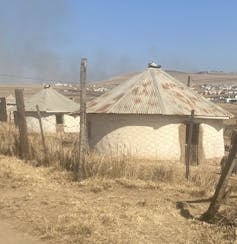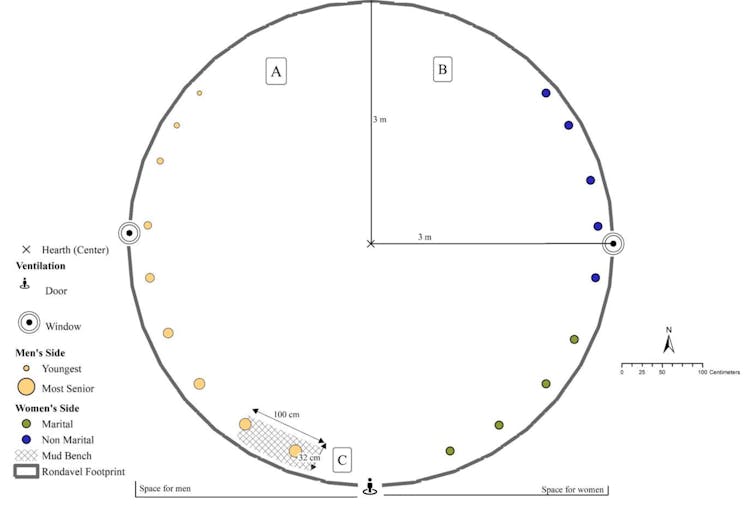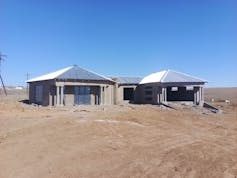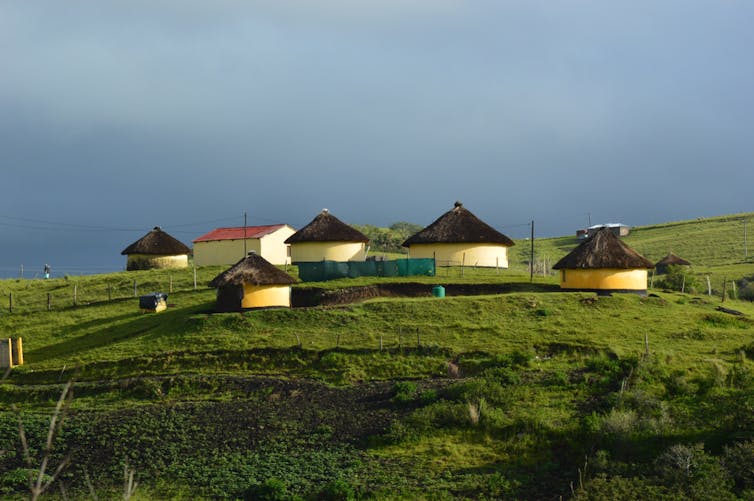The Mbhashe area of South Africa’s Eastern Cape province is a landscape of hills, fields and river valleys leading to the Indian Ocean. All along the ridges are the homesteads of the Xhosa people who have lived here since before colonial times. In years gone by, all these homes would have been round buildings (“rondavels”) plastered with mud and thatched with local grasses. Today, many are built with bricks and cement and roofed with zinc. Some houses are rectangular, with decorative pillars, verandas and flat roofs.
Sinenhlanhla Memela, Author provided (no reuse)
South Africa’s history of labour migration saw generations of people forced to leave these family homes to find work. But many people strongly connect with rural homes, where umbilical cords are buried as an indication of symbolic attachment to the place. People return home during holidays, when they are sick, to attend ceremonies, after retirement, and to be buried.
The rural Xhosa home looks somewhat different these days. Missionaries and colonists introduced buildings constructed using sun-dried brick and mortar with corrugated iron sheets for roofing. Migration, urbanisation and economic status also influenced the change. People admired urban architecture and could afford their desired building materials, and migration allowed designs and plans to travel.

Sinenhlanhla Memela, Author provided (no reuse)
As a geographer, I’m interested in the way space is produced and used, and the influencing factors and impacts. Recently I worked with a PhD student, Africa Ndude, on a study to explore the way traditional Xhosa customs fit in to new homes. Some customary practices and ideas relate specifically to certain parts of the traditional rondavel, and to a specific rondavel on the property. I wanted to know if that had changed over time.
We used the Mbhashe area as a case study because it hadn’t yet been featured in research on vernacular architecture.
We asked study participants to discuss the cultural utilisation of the traditional family house (indlu enkulu, the main rondavel) and whether changing building design and materials had influenced their cultural practices. We interviewed 10 people, aged 24-48, at their homes, to get an in-depth understanding. We also gave them a rondavel diagram to help them explain what happened in different parts of the house.
The interviews revealed that architectural changes had not changed the cultural norms, values, habits and behaviours attached to rondavels. Some people found ways to fit cultural ideas into contemporary house design – with adjustments for health and medical innovations.
We hope this study raises awareness about the cultural importance of indigenous architecture, and starts a conversation about how to preserve it.
Traditional family house rondavel
Among amaXhosa, the main rondavel is usually one of a cluster of structures at the homestead (umuzi). It is spatially divided based on gender, as shown in this figure.


Sinenhlanhla Memela, Author provided (no reuse)
The area labelled A is for men, and B is for women. People sit and sleep in the areas designated for their gender. The seating arrangement is based on seniority rather than age. Married women are regarded as senior to unmarried women, and men’s seating depends on when a man was initiated.
Traditionally, the family house was used for home birth because access to health facilities was limited in rural areas, but the practice is no longer common. During childbirth, men were not permitted into the space. Birth took place behind the door, in the women’s section.
In the centre of the family house is a hearth (eziko) used by women to prepare food or men to roast corn. People are served in their designated area. As men are responsible for serving meat and beer, it is also stored in the space for men, furthest from the door. The domestic essentials such as a table and cupboard, crockery, cutlery and ilitye lokuguba, a flat rock used to grind food, are located in the women’s area.
A spear (umkhonto) is stuck into the roof above the doorway on the men’s side. Men use the spear to slaughter animals during a ritual or ceremony. The spear is believed to guard against lightning during a storm.
When a family member dies, the coffin is traditionally placed in section B a day before the funeral. Senior women will sleep next to the coffin. The family elder will burn incense (a plant called impepho) to ask the ancestors to welcome the deceased.
The participants also use the family house rondavel to interact with each other in daily activities and with their ancestors during ceremonies.
Changing architectural designs
Over 66% of households in the Mbhashe municipality are traditional dwellings. There are a few contemporary houses built with bricks or blocks. Some households have a modernised rondavel; others do not have a rondavel at all. There are no planning policies in rural areas: villagers can build the type of house they want.


Sinenhlanhla Memela, Author provided (no reuse)
The residents we interviewed admired modern homes (including those who didn’t have them yet). Multiple rooms, materials like tiles and concrete, and features like lighting were seen as desirable, progressive and convenient. One told us:
I too [wish to have a modern house] because these are the houses that are built nowadays, and they make the home beautiful.
We heard that some uses of traditional family houses are adaptable to contemporary structures, such as performing ceremonies for ancestors. As one participant put it:
Any house structure can be used as a rondavel; it does not change the culture. It is the same.
But some people preferred to avoid adapting elements to contemporary houses. They said they would rather have two structures: one modern and one for uses that cannot be adapted to the modern space.


Julie Scheveneels/ Shutterstock
Women mostly give birth in hospitals and clinics now. If they do give birth at home, it’s because they can’t reach a health facility – not for a cultural reason. Since 2016, home deliveries have decreased to 4% nationally.
The participants told us that until the COVID-19 pandemic, the deceased’s coffin was still placed in the modern family house for a final ceremony the day before the funeral. South African COVID-19 restrictions prohibited these night vigils. Nowadays, most people bring the coffin to the house on the day of the funeral, burn incense and ask the ancestors to welcome the deceased.
People also do not opt to sleep on the floor these days unless there is a ceremony.
There is no hearth in the new house, but food may still be prepared in the B section of a rondavel on a gas or electric stove. Some will store and prepare food in the kitchen of the modern house, but serve it in the traditional rondavel.
Whatever the architectural design, and despite some changes in practice, Xhosa culture lives on in the homes of Mbhashe.




















Discussion about this post